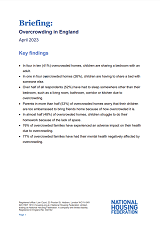Briefing: Overcrowding in England

Published by the National Housing Federation, this report explores the impact overcrowding has on a family’s physical and mental health, wellbeing, daily lives and relationships.
One of the strongest indicators that all is not well in our housing system is the level of overcrowding experienced by people in all tenures. Overcrowding in the social sector is indicative of a shortage of available housing of the right size, and in the private sector it is indicative of the affordability issues faced by households in trying to find a home large enough for their needs.
This paper looks at the scale of overcrowding as measured in the English Housing Survey and the impact on families who deem themselves to be living in overcrowded conditions. The paper includes polling carried out by Savanta which reveals the detrimental impact that living in overcrowded conditions has on the health, wellbeing and daily lives of those affected:
- More than 310,000 children (313,244) in England are forced to share beds with other family members.
- One in every six children is being forced to live in cramped conditions because their family cannot access a suitable and affordable home. This equates to two million children from 746,000 families.
- Households from minority ethnic backgrounds are three times as likely to be affected by overcrowding than white households.
- Over two thirds (70%) of overcrowded families say they have experienced both poor mental and poor physical health as a direct result of overcrowding.
- A quarter of parents in overcrowded homes are regularly forced to sleep elsewhere, such as in a living room, bathroom, hallway or kitchen because of the lack of space.
The National Housing Federation is calling for a long-term, national plan for meeting housing need, with the aim of driving a drastic increase in the number of affordable homes over the next decade.
